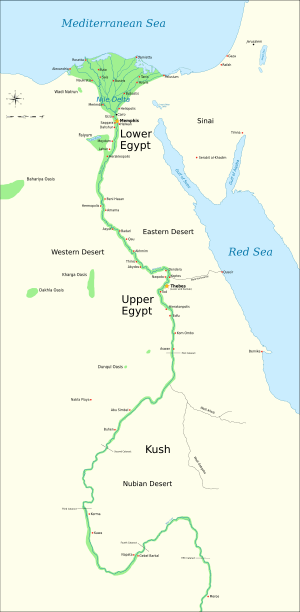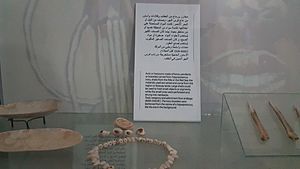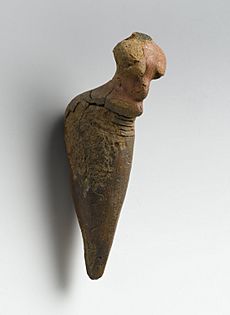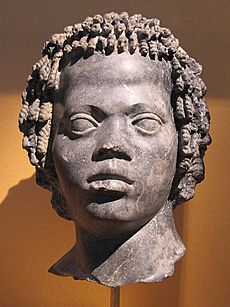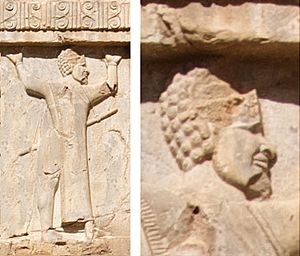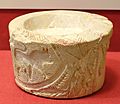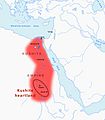Nubia facts for kids

Nubia was an ancient African Kingdom. It dates back to around 6000 BC. It was in northeastern Africa.
They were a valuable culture because of their trading abilities. They were on the coast of the Red Sea. That gave them many ports from which they were able to trade. This culture, though, had many hardships. It declined in power many times, which forced it to break up into smaller kingdoms which flourished on their own. These are commonly referred to as the A-Group, B-Group, and C-Group. Their true decline was around 350 AD, when the kingdom of Axum invaded and broke up the culture once again. This time, the culture never recovered its strength, thus ending of Historic Nubia.
Today, the region of Nubia is split between Egypt and Sudan.
Contents
Geography
Nubia was divided into three major regions: Upper, Middle, and Lower Nubia, in reference to their locations along the Nile. Lower refers to regions downstream and upper refers to regions upstream. Lower Nubia lies between the First and the Second Cataracts, within the current borders of Egypt. Middle Nubia lies between the Second and the Third Cataracts. Upper Nubia lies south of the Third Cataract.
History
Prehistory
Early settlements sprouted in both Upper and Lower Nubia. Egyptians referred to Nubia as "Ta-Seti," or "The Land of the Bow," since the Nubians were known to be expert archers. Modern scholars typically refer to the people from this area as the "A-Group" culture. Fertile farmland just south of the Third Cataract is known as the "pre-Kerma" culture in Upper Nubia, as they are the ancestors.
The Neolithic people in the Nile Valley likely came from Sudan, as well as the Sahara, and there was shared culture with the two areas and with that of Egypt during this period. By the 5th millennium BC, the people who inhabited what is now called Nubia participated in the Neolithic revolution. Saharan rock reliefs depict scenes that have been thought to be suggestive of a cattle cult, typical of those seen throughout parts of Eastern Africa and the Nile Valley even to this day.
Megaliths discovered at Nabta Playa are early examples of what seems to be one of the world's first astronomical devices, predating Stonehenge by almost 2,000 years. This complexity as observed at Nabta Playa, and as expressed by different levels of authority within the society there, likely formed the basis for the structure of both the Neolithic society at Nabta and the Old Kingdom of Egypt. Around 3500 BC, the second "Nubian" culture, termed the A-Group, arose. It was a contemporary of, and ethnically and culturally very similar to, the polities in predynastic Naqada of Upper Egypt. The A-Group people were engaged in trade with the Egyptians. This trade is testified archaeologically by large amounts of Egyptian commodities deposited in the graves of the A-Group people. The imports consisted of gold objects, copper tools, faience amulets and beads, seals, slate palettes, stone vessels, and a variety of pots.
Around 3300 BC, there is evidence of a unified kingdom, as shown by the finds at Qustul, that maintained substantial interactions (both cultural and genetic) with the culture of Naqadan Upper Egypt. The Nubian culture may have even contributed to the unification of the Nile Valley.
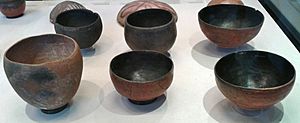
Around the turn of the protodynastic period, Naqada, in its bid to conquer and unify the whole Nile Valley, seems to have conquered Ta-Seti (the kingdom where Qustul was located) and harmonized it with the Egyptian state. Thus, Nubia became the first nome of Upper Egypt. At the time of the first dynasty, the A-Group area seems to have been entirely depopulated, most likely due to immigration to areas west and south.
This culture began to decline in the early 28th century BC. George Reisner suggested that it was succeeded by a culture that he called the "B-Group", but most archaeologists today believe that this culture never existed and that the area was depopulated from c. 3000 BC to c. 2500, when a-group descendants returned to the area. The causes of this are uncertain, but it was perhaps caused by Egyptian invasions and pillaging that began at this time. Nubia is believed to have served as a trade corridor between Egypt and tropical Africa long before 3100 BC. Egyptian craftsmen of the period used ivory and ebony wood from tropical Africa which came through Nubia.
In 2300 BC, Nubia was first mentioned in Old Kingdom Egyptian accounts of trade missions. From Aswan, right above the First Cataract, the southern limit of Egyptian control at the time, Egyptians imported gold, incense, ebony, copper, ivory, and exotic animals from tropical Africa through Nubia. As trade between Egypt and Nubia increased, so did wealth and stability. By the Egyptian 6th dynasty, Nubia was divided into a series of small kingdoms. There is debate over whether these C-Group peoples, who flourished from c. 2500 BC to c. 1500 BC, were another internal evolution or invaders. There are definite similarities between the pottery of the A-Group and C-Group, so it may be a return of the ousted Group-As, or an internal revival of lost arts. At this time, the Sahara Desert was becoming too arid to support human beings, and it is possible that there was a sudden influx of Saharan nomads. C-Group pottery is characterized by all-over incised geometric lines with white infill and impressed imitations of basketry.
During the Egyptian Middle Kingdom (c. 2040–1640 BC), Egypt began expanding into Nubia to gain more control over the trade routes in Northern Nubia and direct access to trade with Southern Nubia. They erected a chain of forts down the Nile below the Second Cataract. These garrisons seemed to have peaceful relations with the local Nubian people, but little interaction during the period. A contemporaneous but distinct culture from the C-Group was the Pan Grave culture, so called because of their shallow graves. The Pan Graves are associated with the East bank of the Nile, but the Pan Graves and C-Group definitely interacted. Their pottery is characterized by incised lines of a more limited character than those of the C-Group, generally having interspersed undecorated spaces within the geometric schemes.
Nubia and Ancient Egypt
One interpretation is that Nubian A-Group rulers and early Egyptian pharaohs used related royal symbols. Similarities in rock art of A-Group Nubia and Upper Egypt support this position. Ancient Egypt conquered Nubian territory in various eras, and incorporated parts of the area into its provinces. The Nubians in turn were to conquer Egypt under its 25th Dynasty.
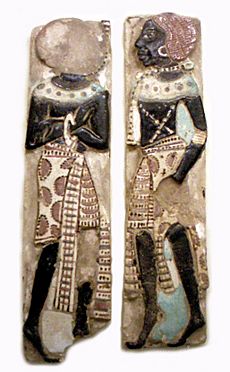
However, relations between the two peoples also show peaceful cultural interchange and cooperation, including mixed marriages. The Medjay (mj3,) represents the name ancient Egypt gave to a region in northern Sudan where an ancient people of Nubia inhabited. They became part of the Egyptian military as scouts and minor workers.
During the Middle Kingdom of Egypt, "Medjay" no longer referred to the district of Medja but to a tribe or clan of people. It is not known what happened to the district, but, after the First Intermediate Period of Egypt, it and other districts in Nubia were no longer mentioned in the written record. Written accounts detail the Medjay as nomadic desert people. Over time, they were incorporated into the Egyptian army. In the army, the Medjay served as garrison troops in Egyptian fortifications in Nubia and patrolled the deserts as a kind of gendarmerie. This was done in the hope of preventing their fellow Medjay tribespeople from further attacking Egyptian assets in the region. Later, they were even used during Kamose's campaign against the Hyksos and became instrumental in making the Egyptian state into a military power.
By the Eighteenth Dynasty of the New Kingdom period, the Medjay were an elite paramilitary police force. No longer did the term refer to an ethnic group and, over time, the new meaning became synonymous with the policing occupation in general. Being an elite police force, the Medjay were often used to protect valuable areas, especially royal and religious complexes. Though they are most notable for their protection of the royal palaces and tombs in Thebes and the surrounding areas, the Medjay were known to have been used throughout Upper and Lower Egypt.

Various pharaohs of Nubian origin are held by some Egyptologists to have played an important part towards the area in different eras of Egyptian history, particularly the 12th Dynasty. These rulers handled matters in typical Egyptian fashion, reflecting the close cultural influences between the two regions.
In the New Kingdom, Nubians became indistinguishable in the archaeological record from Egyptians.
Kerma
From the pre-Kerma culture, the first kingdom to unify much of the region arose. The Kerma Culture, named for its presumed capital at Kerma, was one of the earliest urban centers in the Nile region and spoke languages of the Cushitic branch. By 1750 BC, the kings of Kerma were powerful enough to organize the labor for monumental walls and structures of mud brick. They also had rich tombs, with possessions for the afterlife and large human sacrifices. George Andrew Reisner excavated sites at Kerma and found distinctive Nubian architecture such as large tombs and palace-like structures. At one point, Kerma came very close to conquering Egypt. Egypt suffered a serious defeat at the hands of the Kingdom of Kush.
According to Davies, head of the joint British Museum and Egyptian archaeological team, the attack was so devastating that, if the Kerma forces had chosen to stay and occupy Egypt, they might have eliminated it for good and brought the nation to extinction. When Egyptian power revived under the New Kingdom of Egypt (c. 1532–1070 BC), Egyptians began to expand further southwards. The Egyptians destroyed Kerma's kingdom and capitol and expanded the Egyptian empire to the Fourth Cataract.
By the end of the reign of Thutmose I (1520 BC), all of northern Nubia had been annexed. The Egyptians built a new administrative center at Napata, and used the area to produce gold and incense. The Nubian gold production made Egypt a prime source of the precious metal in the Middle East. The primitive working conditions for the slaves are recorded by Diodorus Siculus, who saw some of the mines at a later time. One of the oldest maps known is of a gold mine in Nubia, the Turin Papyrus Map dating to about 1160 BC; this map is also one of the earliest characterized road maps in existence.
Kush
Napatan period
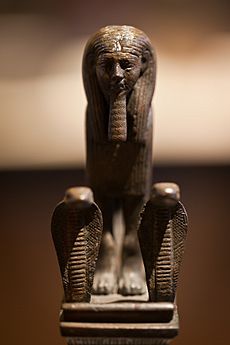
When the Egyptians pulled out of the Napata region, they left a lasting legacy that was merged with indigenous customs, forming the kingdom of Kush. Archaeologists have found several burials in the area that seem to belong to local leaders. The Kushites were buried there soon after the Egyptians decolonized the Nubian frontier. Kush adopted many Egyptian practices, such as their religion. The Kingdom of Kush survived longer than that of Egypt, invaded Egypt (under the leadership of king Piye), and controlled Egypt during the 8th century BC as the Twenty-fifth Dynasty of Egypt.
The Kushites held sway over their northern neighbors for nearly 100 years, until they were eventually repelled by the invading Assyrians. The Assyrians forced them to move farther south, where they eventually established their capital at Meroë. Of the Nubian kings of this era, Taharqa is perhaps the best known. A son and the third successor of the founding pharaoh, Piye, he was crowned in Memphis, Egypt c. 690. Taharqa ruled over both Nubia and Egypt, restored Egyptian temples at Karnak, and built new temples and pyramids in Nubia before being driven from Egypt by the Assyrians.
Meroitic period
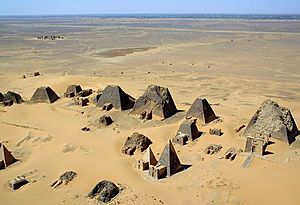
Meroë (800 BC – c. AD 350) in southern Nubia lay on the east bank of the Nile, about 6 km north-east of the Kabushiya station near Shendi, Sudan, ca. 200 km north-east of Khartoum. The people there preserved many ancient Egyptian customs, but were unique in many respects. They developed their own form of writing, first utilizing Egyptian hieroglyphs, and later using an alphabetic script with 23 signs. Since king Arakamani the kings were buried in Meroe.
Achaemenid period
The Achaemenids occupied the Kushan kingdom, possibly from the time of Cambyses (circa 530 BCE), and more probably from the time of Darius I (550-486 BCE), who mentions the conquest on Kush (Kušiya) in his inscriptions.
Strabo describes a clash with the Romans in which the Romans defeated Nubians. According to Strabo, following the Kushite advance, Gaius Petronius (a Prefect of Egypt at the time) prepared a large army and marched south. The Roman forces clashed with the Kushite armies near Thebes and forced them to retreat to Pselchis (Maharraqa) in Kushite lands. Petronius then sent deputies to the Kushites in an attempt to reach a peace agreement and make certain demands.
Quoting Strabo, the Kushites "desired three days for consideration" in order to make a final decision. However, after the three days, Kush did not respond and Petronius advanced with his armies and took the Kushite city of Premnis (modern Karanog) south of Maharraqa. From there, he advanced all the way south to Napata, the second Capital in Kush after Meroe. Petronius attacked and sacked Napata, causing the son of the Kushite Queen to flee. Strabo describes the defeat of the Kushites at Napata, stating that "He (Petronius) made prisoners of the inhabitants".
During this time, the different parts of the region divided into smaller groups with individual leaders, or generals, each commanding small armies of mercenaries. They fought for control of what is now Nubia and its surrounding territories, leaving the entire region weak and vulnerable to attack. Meroë would eventually meet defeat by the new rising Kingdom of Aksum to their south under King Ezana.
The classification of the Meroitic language is uncertain; it was long assumed to have been one of the Afroasiatic languages like the Egyptian language, but is now considered to have likely been one of the Eastern Sudanic languages.
At some point during the 4th century, the region was conquered by the Noba, from which the name Nubia may derive; another possibility is that it comes from the Egyptian word for gold. From then on, the Romans referred to the area as Nobatia.
Christian Nubia
Around AD 350, the area was invaded by the Kingdom of Aksum and the Meroitic kingdom collapsed. Eventually, three smaller Christian kingdoms replaced it: northernmost was Nobatia between the first and second cataract of the Nile River, with its capital at Pachoras (modern-day Faras); in the middle was Makuria, with its capital at Old Dongola; and southernmost was Alodia, with its capital at Soba (near Khartoum). King Silky of Nobatia crushed the Blemmyes, and recorded his victory in a Greek inscription carved in the wall of the temple of Talmis (modern Kalabsha) around AD 500.
While bishop Athanasius of Alexandria consecrated one Marcus as bishop of Philae before his death in 373, showing that Christianity had penetrated the region by the 4th century, John of Ephesus records that a Monophysite priest named Julian converted the king and his nobles of Nobatia around 545. John of Ephesus also writes that the kingdom of Alodia was converted around 569. However, John of Biclarum records that the kingdom of Makuria was converted to Catholicism the same year, suggesting that John of Ephesus might be mistaken. Further doubt is cast on John's testimony by an entry in the chronicle of the Greek Orthodox Patriarch of Alexandria Eutychius, which states that in 719 the church of Nubia transferred its allegiance from the Greek to the Coptic Orthodox Church.
By the 7th century, Makuria expanded becoming the dominant power in the region. It was strong enough to halt the southern expansion of Islam after the Arabs had taken Egypt. After several failed invasions the new rulers agreed to a treaty with Dongola, called Baqt, allowing for peaceful coexistence and trade. This treaty held for six hundred years. Over time the influx of Arab traders introduced Islam to Nubia and it gradually supplanted Christianity. While there are records of a bishop at Qasr Ibrim in 1372, his see had come to include that located at Faras. It is also clear that the cathedral of Dongola had been converted to a mosque in 1317.
The influx of Arabs and Nubians to Egypt and Sudan had contributed to the suppression of the Nubian identity following the collapse of the last Nubian kingdom around 1504. A vast majority of the Nubian population is currently Muslim, and the Arabic language is their main medium of communication in addition to their indigenous old Nubian language. The unique characteristic of Nubian is shown in their culture (dress, dances, traditions, and music).
Islamic Nubia
In the 14th century, the Dongolan government collapsed and the region became divided and dominated by Arabs. The next centuries would see several Arab invasions of the region, as well as the establishment of a number of smaller kingdoms. Northern Nubia was brought under Egyptian control, while the south came under the control of the Kingdom of Sennar in the 16th century. The entire region would come under Egyptian control during the rule of Muhammad Ali in the early 19th century, and later became a joint Anglo-Egyptian condominium.
Contemporary issues
With the end of colonialism and the establishment of the Republic of Egypt (1953), and the secession of the Republic of Sudan from unity with Egypt (1956), Nubia was divided between Egypt and Sudan.
During the early-1970s, many Egyptian and Sudanese Nubians were forcibly resettled to make room for Lake Nasser after the construction of the dams at Aswan. Nubian villages can now be found north of Aswan on the west bank of the Nile and on Elephantine Island; and many Nubians now live in large cities, such as Cairo.
Images for kids
-
11th Dynasty model of Nubian archers in the Egyptian army, from a tomb in Asyut (c. 2130–1991 BC).
-
Nubian Prince Heqanefer bringing tribute for King Tutankhamun, 18th dynasty, Tomb of Huy. Circa 1342 – c. 1325 BC
-
Kushite heartland, and Kushite Empire of the Twenty-fifth Dynasty of Egypt, circa 700 BC.
-
Taharqa's kiosk and column, Karnak temple
-
Jewelry of Kandake Amanishakheto
-
Copy of relief from Naqa depicting Amanitore (second from left), Natakamani (second from right) and two princes approaching a three-headed Apedemak.
-
The Relief of Gebel Sheikh Suleiman probably shows the victory of an early Pharaoh, possibly Djer, over A-Group Nubians circa 3000 BC.
See also
 In Spanish: Nubia para niños
In Spanish: Nubia para niños


